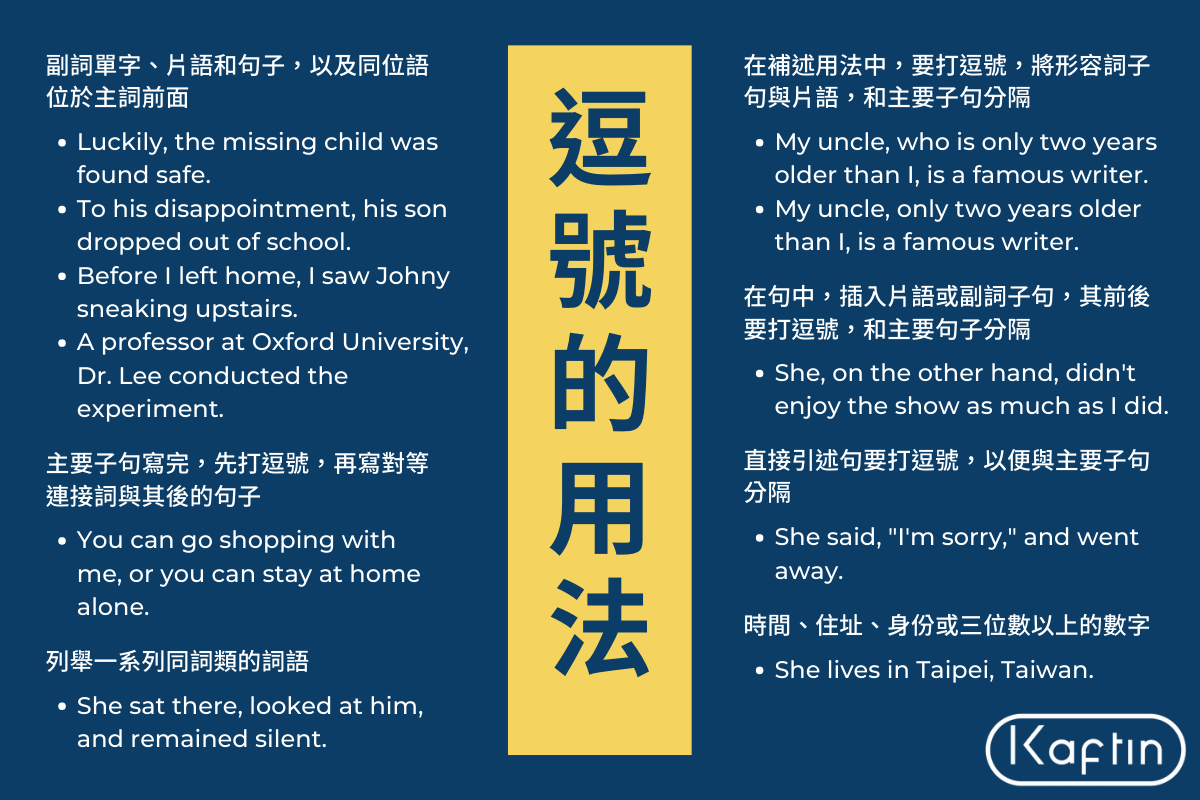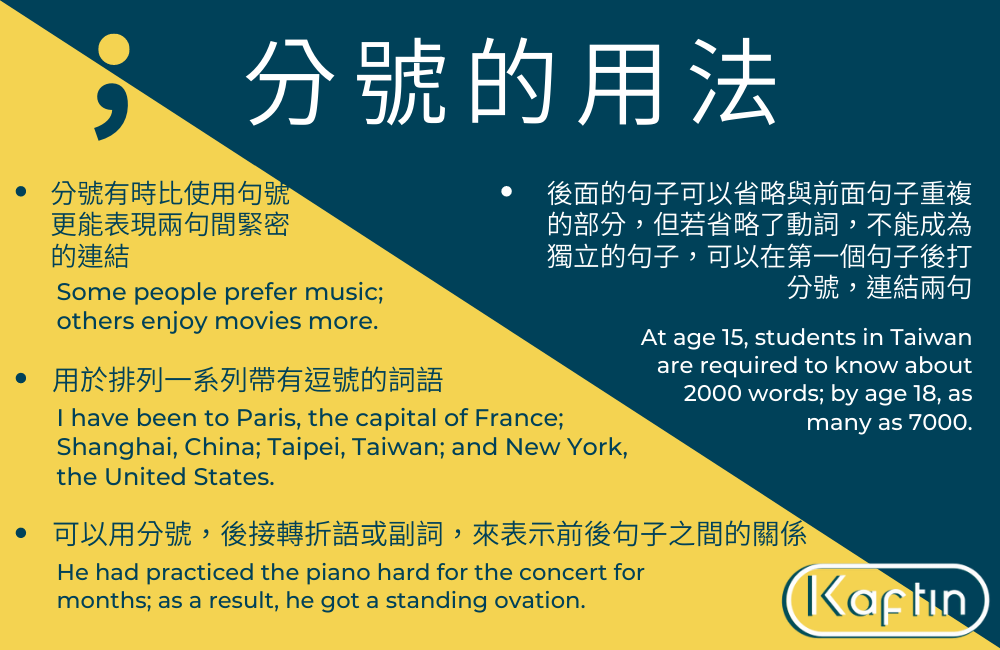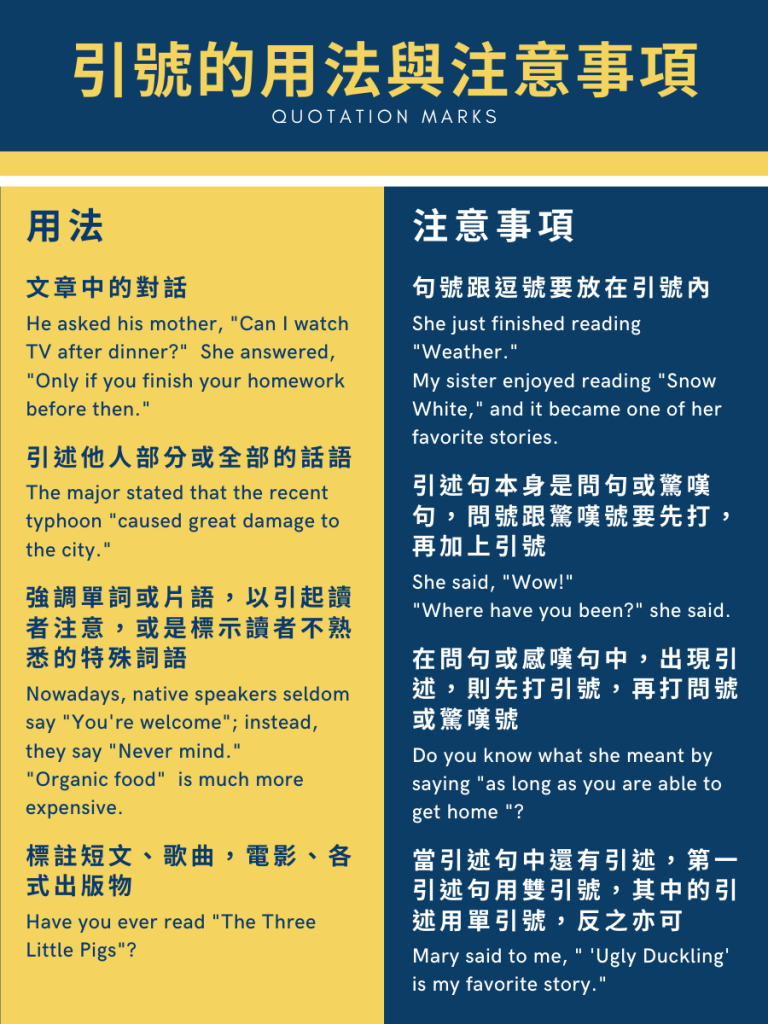英文標點符號
一般人最為熟悉的英文標點符號為逗號、句號、問號、驚嘆號、引號、連字號跟撇號,因為這幾個標點符號幾乎出現在所有的文章中。但是,很多人對最為常用的逗號跟引號的一些規則都可能不是很清楚,更別說英文其他的標點符號,像是分號、冒號、破折號、括號的用法了。然而,這些標點符號用的好,會讓文章的程度,提昇很多。接下來,我們將透過說明與例句來介紹上述的每個英文標點符號的用法。
(由於本文章透過句子結構來解釋標點符號的使用,有需要的話,讀者可以閱讀『理解句子結構,英文文法變簡單』一文。)
句號(Period)
句號的用法有兩種:
- 英文的每個句子闡述一個完整的意思,在一個結構完整的句子的結尾,打上句號。打字時,要空兩格,再開始打另外一個句子。
例:I enjoy listening to music. - 在縮寫時候用
例:Mr. and Mrs. Smith are coming tonight.
要注意的一點是,當被縮寫的字剛好落在句尾,只要打一個句號就好。例如:I usually wake up at 7 A.M.
逗號(Comma)
英文的逗號是文章中必然會出現的標點符號之一,它的用法相當多,並且與英文句子結構的觀念有很大的關係。很多人對於英文逗號的用法不是那麼清楚,用中文寫作的習慣來打逗號,導致文章出現很大的問題。
英文逗號的用法如下:
- 跟中文的頓號用法類似,用於列出三個以上相同型式的單字,片語和句子-這種情況下,逗號等同對等連接詞
I did my homework, watched television, and read a book last night.
She helped a lot of people, including Mary, John, and me. - 主詞前面的副詞片語如果很長,最好打逗號,讓讀者知道接下來要出現的是主詞,會讓讀者容易理解句意。但是,
Despite his invitation to his Christmas party, I decided to stay at home.
如果這個片語很短的話,就不用打逗號
In 2019 I went to Japan on business. - 用對等連接詞(for, and, nor, but, or, yet跟so)連接兩個句子,對等連接詞前面的句子寫完後要打逗號,再寫對等連接詞跟其後的句子。
They liked the house, but they didn’t have enough money to buy it.
如果對等子句太短,也可以不打逗號。
I called for help and she came. - 先寫副詞子句(用because, though, after, before, until, when…等連接詞帶領的句子),再寫主要子句時,副詞子句的後面要打逗號
Because she stayed up late last night, she dozed off in class this morning. - 寫完轉換詞(像therefore, instead, however, thus, as a result, first, on the other hand)後,要打逗號,再寫句子
I didn’t go to her party. Instead, I went to a movie alone. - 在形容詞子句的補述用法中,要先打逗號,再寫關係詞所帶領的形容詞子句,若是這個形容詞子句寫在主要句子的中間,則前後都要打逗號
All of us admired his father, who is a famous professor.
Mary, whose mother is my teacher, is the cleverest girl I have ever known. - 補述用法中,當關係代名詞為所帶領的形容詞子句的主詞(也就是,關係代名詞後面直接接著動詞),可以破壞動詞,省略關係代名詞,逗號要留下
His father, working at Google, is busy every day. - 分詞構句為副詞時,要用逗號與主要子句隔開
The weather being warm, we went on a picnic. - 在一個句子中間插入有連接詞的另一個句子,或插入片語(插入語),且省略這個片語或句子,並不影響句意,則插入句或插入語前後要打逗號,以便和主要句子分隔
All students, if they want to have good grades, should study hard.
The year of his birth, 2020, was an eventful one. - 同位語前後都要打逗號
My friend, Mary, will go with me. - 句末直接引述句前要打逗號。如果這個引述句在句子中間,則前後都要打逗號
She said, “I’m sorry.”
She said, “I’m sorry,” and went away. - 如果句子有感歎詞,用逗號將感嘆詞與句子隔開
Hey, watch out! - 在句子當中,直接稱呼說話對象的名字時,名字前後要用逗號與主要句子隔開
I think, David, you are right. - 時間、住址、身份或三位數以上的數字要打逗號
On December 24, 1999, Melisa Wong left for New York.
She lives in Taipei, Taiwan.
Julia Lin, MD, will give a speech tomorrow.
14,000; 1,402,345
比較有逗號(非限定結構-類似補述用法)跟沒有逗號(限定結構-類似限定用法)的差別:
His dog, Lucky, is a pitbull.
他只有一隻狗
His dog Lucky is a pitbull.
他有很多狗

國人在使用逗號時,常見的錯誤:
- 逗號不能用來連接兩個句子
X The police showed up at his party, they arrested many of his friends.
訂正方法:加上連接詞,或直接用句號分成兩句 - 用and或or連接兩個字或片語,而不是兩個句子時,不要打逗號
She went home and prepared for dinner. - 排列一系列的含有逗號的單字跟片語時,不能都用逗號,否則讀者難以理解
X I have been to Paris, the capital of France, Shanghai, China, Taipei, Taiwan, and New York, the United States.
訂正方法:使用分號來排列含有逗號的項目
√ I have been to Paris, the capital of France; Shanghai, China; Taipei, Taiwan; and New York, the United States. - such as 前要不要打逗號,要看省略這個片語後,句意會不會變奇怪(非限定結構或限定結構)
Foods such as pizza and ice cream are not good for health. (如果拿掉such as pizza and hamburger,句子的意思就變奇怪了,這時就不能打逗號-限定結構。)
I like Citrus fruits, such as oranges and lemons. (將such as oranges and lemons省略,句意不會變得奇怪,就要打逗號-非限定結構。)
逗號與前面的字中間,不要空格,與後面的字要空一格
分號(Semicolon)
分號是一個很多人不會使用,甚至完全沒注意到的標點符號。一篇英文作文中,如果分號用的好,會顯得程度比較高,有加分的效果。它的用法如下:
- 等於對等連接詞,用於分隔地位相等的兩個句子, 有時比使用句號更能表現兩句間緊密的連結
Some people prefer music; others enjoy movies more. - 用於排列一系列帶有逗號的詞語,為了語意清晰,要使用分號來排列
I have been to Paris, the capital of France; Shanghai, China; Taipei, Taiwan; and New York, the United States. - 不使用連接詞連接兩個句子,可以用分號,後面接轉折語或副詞,來表示兩個句子之間的關係
He had practiced the piano hard for the concert for months; as a result, he got a standing ovation. - 當兩個句子有相同的動詞,或主詞與動詞,後面的句子可以省略重複的部分,但因為少了動詞,不能成為獨立的句子,可以在第一個句子後打分號,連結兩句,表示兩個句子的關係密切
At age 15, students in Taiwan are required to know about 2000 words; by age 18, as many as 7000.

引號(Quotation Mark)
引號分成兩種,一種是單引號(英式),一種是雙引號(美式),我們使用雙引號。引號的用法為:
- 文章中,分隔文章與對話
He asked his mother, “Can I watch TV after dinner?” She answered, “Only if you finish your homework before then.”
“He will not go tomorrow,” she said. - 用於引述他人部分或全部的話語
The mayor stated that the recent typhoon “caused great damage to the city.” - 標註短文、歌曲,電影、各式出版物
Have you ever read “The Three Little Pigs”? - 引號用來強調單詞或片語,以引起讀者注意,或是標示讀者不熟悉的特殊詞語
Nowadays, native speakers seldom say “You’re welcome”; instead, they say “Never mind.”
“Organic food” is much more expensive.

國人對引號的用法常見的困惑:
- 句號跟逗號要放在引號內
She just finished reading “Weather.”
My sister enjoyed reading “Snow White,” and it became one of her favorite stories. - 引述句本身的問號跟驚嘆號要先打,再加上引號
She said, “Wow!”
“Where have you been?” she said. - 在問句或感嘆句中,出現引述,則先打引號,再打問號或驚嘆號
When she saw me hit by the man, all she said was, ‘What a mess’!
Do you know what she meant by saying “as long as you are able to get home “? - 當引述句中還有引述,第一引述句用雙引號,其內的引述用單引號,反之亦可
Mary said to me, ” ‘Ugly Duckling’ is my favorite story.”
破折號(Dash)
常用的兩種破折號是Em dash(長一點)跟En dash (短一點):
使用Em dash破折號代替括弧跟冒號,更能強調內容。但是很少人能夠靈活應用這個標點符號。以下介紹他的用法:
- 可以用破折號來表示一個想法的急轉或突然中斷
I hope my mother–. But I’d rather not talk about it. - 句子中有插入片語時,用破折號取代逗號,具有強調的意思
When he was born–nearly two months premature–his parents were anxious. - 句子中有太多逗號,導致閱讀困擾,可以用破折號來將不同的完整概念區分出來
After traveling around many countries–including Japan, Korea, China, and Singapore–she has become more confident, - 用來強調句子的最後一個字、片語或句子(這個用法,不可用逗號或括號代替)
I found the word that best described her–ambitious.
He started his business for one reason–to be his own boss.
At this moment one thing is certain–we are not going to be there in time. - 在寫作中運用對話時,用於破折號表示說話中斷
I think I have seen–oh yes, I saw him at John’s birthday party. - 用破折號表示引述的來源
If I can’t picture it, I can’t understand it. –Albert Einstein
使用En dash破折號來表示時間區間,或將兩組既定片語連結
- The teacher assigned pages 25-31 for today’s reading material.
- The Nobel Prize-winning physician will give a speech tonight.
冒號(Colon)
冒號能夠吸引讀者注意力,並且清楚的指出重要訊息,因此,許多作者會使用冒號來引導出他們的主要主張或是支持證明。他經常用來條列,通常在英文寫作中,冒號不常被使用。 它的使用準則較為嚴謹,但也相對容易被記住。
- 介紹一個或多個以逗號分隔的項目
We have five senses: sight, hearing, smell, taste, and touch. - 當引號內包含多個句子,許多作者會傾向使用冒號而非逗號來引出內容
- 兩個句子,第二個子句用來敘述、說明、改寫或延伸第一個句子,則在第一個句子後面打冒號
She realized that her dream was coming true: she was going to be an actress. (冒號後獨立的子句說明她的夢想) - 冒號後面也可以接單一個字、片語或句子,表示導致的某種結果
He fell asleep during the math test: he failed.
請注意:
- 冒號後的第一個字母不要大寫,除非是專有名詞
- 接在冒號之後的內容不一定要是完整的句子,可以是單詞或片語
- 冒號不可以分隔兩個平等並且無相關的兩個子句
- 不要過度使用冒號
括號(Parentheses)
括號用來補充與句中相關的資訊,跟逗號是可以互通的,常在正式的學術文章中,用來代替逗號,因為括號可以防止補述的插入部分干擾句子結構。如果一個句子中,出現太多逗號,也可以使用括號來取代其中一組資訊,讓讀者容易閱讀。請注意
- 補述用法中,直接代替逗號,讓文章句型多變化
Dr. Brown(who devoted himself to childhood education) died last night.
問號(Question Mark)
問號用在任何形式的問句:
- 直接問句的後面打問號
Where is she? - 附加問句
It’s a beautiful day, isn’t it? - “Right?” she asked.
- 如果問號出現在括弧內,表示作者對資訊並不確定或有疑慮
Dr. Jefferson lived from 1158(?) to 1212.
請注意:英文分直接跟間接兩種問句,間接問句不能打問號,要打句號。
- Do you know where she is?
這個句子的主要句子是問句 - 間接問句不能打問號
I don’t know where she is.
驚嘆號(Exclamation Mark / Point)
使用驚嘆號來表示驚訝或感嘆,還有表達一個強烈情緒。請不要過使用驚嘆號,不然,就沒什麼驚嘆效果了。
- 加在感嘆句後
What a pity!
How beautiful she is! - 加在直述句後
She is so amazing! - Nonsense! I don’t believe you.
- Get out!
撇號(Apostrophe)
撇號用在:
- 構成名詞所有格
the girl’s - 主詞與be動詞或助動詞的縮寫
she’ll; I’m
省略符號(Ellipsis)
省略符號由三個句點構成,當出現在句子結尾時,要再加上一個句號。它的用法為:
- 引述文章或他人的話時,當不影響作者語意時,可以將一部分用省略符號表示
She wrote, “…come to my office when you have a chance. We can discuss it further and….” - 在說話中表示猶豫或遲疑
She said, “If you really want to quit your job…just do it.”
連字號(Hyphen)
連字號的用法如下:
- 用來連接兩個字以上,成為一個複合詞
hard-working, mother-in-law - 分數寫法
two-thirds - 數字加上另一個字構成形容詞
a 3-day trip



